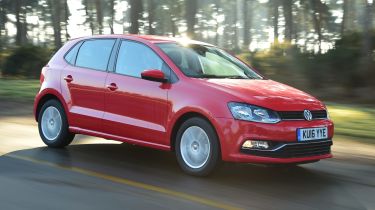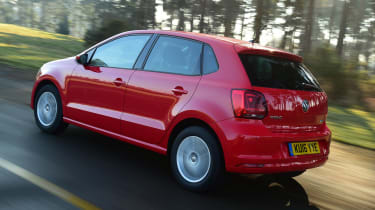Used Volkswagen Polo (Mk5, 2009-2017) - What’s it like to drive?
A wide range of excellent petrol and diesel engines work well with the refined manners of the Polo
The Polo has always been a step behind the Ford Fiesta when it comes to entertainment behind the wheel, mainly due to its rather lifeless steering. However, where the Polo does excel is with its refinement and composure on the move. It feels like a bigger car than it is and the post-2014 facelifted models are even more grown-up than before.
Engines
There are a range of three- and four-cylinder petrol and diesel engines for the Polo, from a mere 59bhp right up to 189bhp. The entry level unit is borrowed from the up! city car, a 1.0-litre MPI normally-aspirated three-cylinder engine of either 59bhp or 74bhp. Be warned, though, it feels markedly underpowered, especially the 59bhp example, thanks to just 95Nm of torque at a relatively high 3,000rpm.
It’s better to opt for the superb 1.2 TSI unit, which produces 89bhp. It returns the same economy and emissions data as the 59bhp MPI engine, but offers a healthier 160Nm of torque from 1,400rpm to make it much more pleasant in day-to-day driving. There's also a 1.0-litre 108bhp TSI, too, which is available on R Line and SEL models.
At the top of the range sit two performance models, the warm BlueGT and the full-blooded GTI hot hatch. The former uses a 1.4-litre TSI engine that produces 148bhp at 5,500rpm and 250Nm from 1,500rpm; it also employs Active Cylinder Technology (ACT), which allows it to shut down two cylinders under light driving demands to save fuel.
Used - available now
The pre-facelift Polo GTI had a 1.4-litre supercharged and turbocharged petrol engine, but this has now been replaced by a muscular 1.8 TSI turbo unit, which is a sleeved-down version of the engine from the Golf GTI. This delivers a robust 189bhp from 4,200 to 6,200rpm and the most torque of any Polo with 320Nm from 1,450rpm to the point that peak power arrives.
All the engines are smooth and pleasant motors, although we think the 1.2-litre is the sweet spot of the range – it’s an enjoyable powerplant that’s more than capable of dealing with the Polo’s weight which is in the 1,100kg ballpark.
There is another petrol option but only on the BlueMotion eco-model – it’s the 1.0-litre turbocharged three-cylinder unit. It delivers more power than the 1.2 TSI with 94bhp at 5,000rpm and matches the 1.2 on torque, delivering 160Nm from 1,500- to 3,000rpm. It’s an excellent little motor that has already spread further up the range with the R Line and SEL models.
The diesel side of the line-up is handled by a solitary 1.4-litre, three-cylinder TDI engine in two forms – rated at either 74bhp at 3,000rpm and 210Nm from 1,500rpm, or 89bhp at 3,500rpm with 230Nm from 1,500rpm. We like this engine, as despite being a touch harsh on start-up, for a diesel in such a small car it’s surprisingly quiet. It is worth noting, however, that the TDI engine is heavier than the TSI units so it renders the Polo less agile in the corners.
Performance ranges from the outright slow to the seriously rapid. The 1.0 MPI engines take at least 14.3s and as much as 15.5s to drag the Polo from 0-62mph, with top speeds struggling to surpass 100mph. Even the 89bhp 1.2 TSI significantly improves the benchmark sprint to 10.8s and the BlueMotion’s 1.0 TSI just edges it at 10.5s.
The TDI is not great on paper, with a 0-62mph time of 12.9 seconds in its low-power guise, but the extra midrange torque it provides is well worth having. And while the GTI obviously takes the performance spoils with a 6.7-second sprint and 146mph capability, don’t overlook the BlueGT – it manages respectable data of 0-62mph in 7.8 seconds and a top speed of 137mph; more than enough for most people’s needs.
On the road
On cars with 16-inch alloy wheels, there’s a slight firmness to the ride, but the Match model's standard 15-inch rims help the soft suspension iron out most bumpy surfaces. There’s a touch more road noise than rivals from Mazda and Ford, but the Polo still feels refined on long motorway journeys.
Happily, this comfort and refinement does not come at the expense of handling. There’s a fair amount of body roll, but grip is good and the Volkswagen isn’t unsettled by mid-corner bumps. The steering is naturally weighted and precise, just not quite as communicative as the Ford Fiesta’s. Visibility is good, making it easy to place the car and in general the predictable Polo inspires confidence on the road.
Transmissions across the range are either five or six-speed manuals – the five on the 1.0 MPI and 1.2 TSI 89bhp engines, the six on the 108bhp 1.2, the 1.0-litre TSI and the 1.4 and 1.8-litre petrols. Both variants of 1.4 TDI have five-speed gearboxes as standard.
A DSG dual-clutch automatic is offered for around £1,400 extra on all models bar the 1.0-litre MPI and TSI engines, and it’s a seven-speed box in all instances. There are no problems with any Polo gearboxes – all are slick operators.
An optional Sport pack was available for the Polo GTI hot hatch, which alters the stability control, dampers, throttle response, exhaust note and steering weighting. While it sharpens up the car’s behaviour, the dampers provide a harsh ride on UK roads. It’s better to stay with the GTI in its standard set-up, where it proves to be an accomplished performance supermini. With plenty of torque, lots of grip and impressive handling, it’s a highly enjoyable car on a back-road blast, although not quite as sharp as a Ford Fiesta ST.












